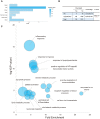Prediction of Drug Positioning for Quan-Du-Zhong Capsules Against Hypertensive Nephropathy Based on the Robustness of Disease Network
- PMID: 30809144
- PMCID: PMC6379470
- DOI: 10.3389/fphar.2019.00049
Prediction of Drug Positioning for Quan-Du-Zhong Capsules Against Hypertensive Nephropathy Based on the Robustness of Disease Network
Abstract
Hypertensive nephropathy (HN) is a medical condition in which chronic high blood pressure causes different kidney damage, including vascular, glomerular and tubulointerstitial lesions. For HN patients, glomerular and tubulointerstitial lesions occur in different renal structure with distinct mechanisms in the progression of renal damage. As an extraction of Eucommia ulmoides, Quan-du-zhong capsule (QDZJN) has the potential to treat HN due to antihypertensive and renal protective activities. Complicated mechanism of HN underlying various renal lesions and the "multi-component and multi-target" characteristics of QDZJN make identifying drug positioning for various renal lesions of HN complex. Here, we proposed an approach based on drug perturbation of disease network robustness, that is used to assess QDZJN positioning for various HN lesions. Topological characteristics of drug-attacked nodes in disease network were used to evaluated nodes importance to network. To evaluate drug attack on the whole disease network of various HN lesions, the robustness of disease networks before/after drug attack were assessed and compared with null models generated from random networks. We found that potential targets of QDZJN were specifically expressed in the kidneys and tended to participate in the "inflammatory response," "regulation of blood pressure," and "response to LPS and hypoxia," and they were also key factors of HN. Based on network robustness assessment, QDZJN may specifically target glomeruli account to the stronger influence on glomerular network after removal of its potential targets. This prediction strategy of drug positioning is suitable for multi-component drugs based on drug perturbation of disease network robustness for two renal compartments, glomeruli and tubules. A stronger influence on the disease network of glomeruli than of tubules indicated that QDZJN may specifically target glomerular lesion of HN patients and will provide more evidence for precise clinical application of QDZJN against HN. Drug positioning approach we proposed also provides a new strategy for predicting precise clinical use of multi-target drugs.
Keywords: Eucommia ulmoides; drug positioning; hypertensive nephropathy; network pharmacology; network robustness.
Figures






References
LinkOut - more resources
Full Text Sources
Molecular Biology Databases
Research Materials

